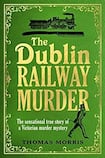
It was a real-life locked room mystery. On a November morning in 1856, the body of George Samuel Little, chief cashier for the Midland Great Western Railway, was found in his office at Dublin’s Broadstone station. His throat had been slashed so deeply he was almost decapitated. There were no signs of a break-in or struggle. The office door was locked from the inside.
Co-workers who broke down the door and found Little lying in a pool of blood thought there was only one possible explanation. “His throat has been cut, and I suspect that it was he who cut it,” railway executive Henry Beausire announced. “Suicide of a railway clerk”, screamed a headline in a Dublin newspaper before the day was out.
Since there appeared to have been no crime committed – an estimated £1,500 in cash was stacked, apparently undisturbed, on Little’s desk – no attempt was made to secure the scene. Employees counted and secured the money and even tidied up the office before detectives arrived to search for clues.
There were loose ends. Where, for instance, was the key Little routinely used to lock himself inside? It was not until the following day when doctors shaved the victim’s head during an autopsy that the truth came to light. Blows from a heavy object had shattered Little’s skull. Someone had managed to enter his office, brutally murder him, and escape.
There seemed to be no motive for the killing of a man Beausire described as “a quiet, amiable, unpresuming and as unoffending a creature as ever breathed”. Then railway officials discovered more than £300 was missing from the office. There had been a robbery after all.
In The Dublin Railway Murder, Thomas Morris unpacks this baffling case with the taut, just-the-facts spareness of the best police procedurals. Readers follow the twists and turns of the case in real time as the mystery deepens and the Dublin Metropolitan Police – and Scotland Yard sleuths called in to help them – come up empty. The vicious crime shocked Dubliners: by Morris’s count, it was the first murder in the city in more than a dozen years.
Investigators were certain the murderer worked for the railway. It had to be someone who knew the layout of the Broadstone station, the location of Little's office and when he would be working alone
Morris, author of two previous books on medical history, deftly peppers the narrative with historical context. We learn how coroners’ inquests worked, the laws of evidence that were in force in 1850s Ireland, and of the widespread distrust of the city’s detectives who were headquartered in Dublin Castle, the hated bastion of British rule over Ireland. One of the city’s papers likened them to a “huge army of spying scoundrels”.
As months passed without an arrest – or progress – the press became hostile. One headline slammed the stalled inquiry as “The Broadstone Farce”. Another news report questioned whether Dublin police possessed the “skill, acuteness, and sagacity” needed to nab the perpetrators of “ingeniously planned crimes”.
Behind the scenes, detectives were questioning numerous witnesses and suspects but getting nowhere. A once confidential file – crammed with notes of police interviews, memos, and letters exchanged between detectives and government officials – allows Morris to reconstruct the investigation in remarkable detail. He is able to document every lead, every dead end, every suspect exonerated.
Investigators were certain the murderer worked for the railway. It had to be someone who knew the layout of the Broadstone station, the location of Little’s office and when he would be working alone. A hammer and razor, the suspected murder weapons, were found when police drained a canal that ran beside the station.
But the long-awaited breakthrough only came seven months after the murder, when a woman came forward and claimed her husband, James Spollin, a handy man and painter at the station, had murdered and robbed Little. Mary Spollin directed the police to caches of stolen money and swore she had watched her husband destroy his bloodstained clothing.
Identifying a suspect was one thing, building a case that would stand up in court was another. The laws of the day prevented a wife from testifying against her husband, forcing prosecutors to cobble together scraps of circumstantial evidence. The drama builds as Spollin’s trial unfolds and Morris recounts the case’s finale and surprising afterlife.
“If an unscrupulous Victorian newspaper editor had been minded to cook up a fictional murder in a desperate attempt to increase sales,” Morris writes, “he could hardly have written a more intriguing story.” In Morris’s hands, it’s an intriguing and compelling true crime whodunit as well.
Dean Jobb's latest book, The Case of the Murderous Dr Cream: The Hunt for a Victorian Era Serial Killer (Algonquin Books), is longlisted for the 2022 Andrew Carnegie Medal for Excellence in Non-Fiction. He teaches in the MFA in creative non-fiction programme at the University of King's College in Halifax, Nova Scotia











